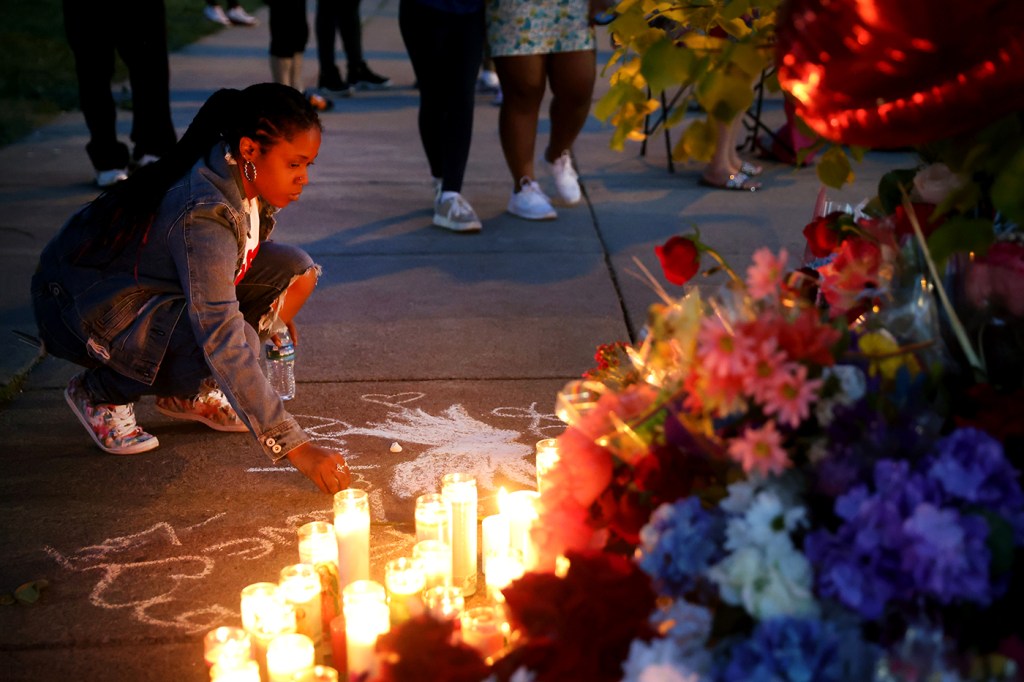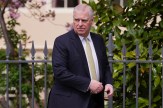As America mourns the victims of the Buffalo shooting, many are left wondering, ‘Where do we go from here?’

Jillian Hanesworth was at her best friend’s baby shower on May 14 when she heard that a shooting had occurred at the nearby Tops Friendly Market in Buffalo, New York.
The only supermarket in Buffalo’s predominantly Black neighborhood was about 20 minutes from the shower, and as Buffalo’s poet laureate and a leader in the city’s Black community, Hanesworth received countless messages asking her to come down to Tops to help with the local response.
“When I got there, there were still people running up to Tops, scanning the parking lot, trying to see if their family members’ cars were in there because they worked there and they weren’t answering the phone,” said Hanesworth, who recently read her poetry during a virtual tribute to the victims of the mass shooting that was organized by Northeastern’s Center for Law, Equity and Race. “Then, the photos and the videos started circulating. Panic and fear turned into anger and grief right before my eyes.”
Hanesworth soon learned that an 18-year-old white man traveled more than three hours to Tops and allegedly fired 50 rounds into the supermarket, killing 10 people and injuring three more. Eleven of the 13 people whom suspect Peyton Gendron allegedly shot were Black, and authorities quickly labeled the mass shooting a “racially motivated hate crime.”
The FBI uncovered a 180-page document allegedly posted online by Gendron that is filled with racist and anti-Semitic language. The document also included a detailed plan for the attack, with a map of the shooter’s route through the supermarket and his reason for targeting the Tops market—its location in a predominantly Black neighborhood.
Gendron also livestreamed the shooting on Twitch. The livestreaming platform has said it took the stream down less than two minutes after the shooting began, but not before countless people posted the video elsewhere online. New York Attorney General Letitia James announced she would be launching an investigation into the social media platforms on which Gendron allegedly planned, promoted, and streamed the attack.
Almost immediately, Hanesworth says she tried to offer the victims a literal shoulder to cry on. One man outside the supermarket told her, “My aunt was in there.” After asking if his aunt had survived, the man simply said, “She’s gone.” His aunt was 86-year-old Ruth Whitfield, the oldest of the 10 victims.
“I didn’t know what to do, so I asked him if he wanted a hug and he said, ‘No.’ But as he was saying ‘no,’ he’s leaning in towards me and I just hugged him,” Hanesworth said.
In the aftermath of the mass shooting, as people in Buffalo and across the country heal and reflect on the events of last weekend, a week before the two-year anniversary of George Floyd’s murder, many have been left wondering: Where do we go from here?
Rev. Willie Bodrick II, senior pastor of Twelfth Baptist Church in Roxbury and a 2020 Northeastern School of Law grad, admitted his initial response to news of the “massacre” in Buffalo was anger and frustration. Even in his community in Boston, Bodrick said the impacts of the mass shooting have been tangible.

Reverend Willie Bodrick II, senior pastor of the Twelfth Baptist Church in Roxbury, hosted Northeastern’s Buffalo: In Tribute and Solidarity event. Photo by Alyssa Stone/Northeastern University
“Trauma is one of those things that kind of reverberates throughout the community, so whether you’re near or far, you’re never too far from the pain of the people,” Bodrick said.
For those like Bodrick who took part in the tribute yesterday, the progress only starts with a conversation.
“Unfortunately, this is not the first mass shooting incident that we have that was racially motivated, and unfortunately it may not be the last,” said Deborah Jackson, managing director of Northeastern School of Law’s Center for Law, Equity and Race. “So, as a community, what can be done concretely to stem this tide? I think part of it is engaging in opportunities just to create broader awareness about the humanity of all people. I think that’s the missing link in all of these incidents that have taken place.”
Bodrick argued “the onus has to be taken on those in power and privilege.” Although Bodrick supports anti-Black hate crime legislation and the federal government cracking down on hate groups, he emphasized that real progress means looking at the systemic roots of racially motivated violence.
“There has to be a serious conversation about what’s being taught in our schools and the importance of creating honest discourses in our curriculums across this country,” Bodrick said. “That can’t be skirted because you can’t legislate out of hate. You can control responses to hate, but I think education is the way to create a community that opposes white supremacist ideology.”
Locally, Hanesworth is also trying to get residents and politicians to re-examine the system as a whole, from housing policy to police funding, “to combat the systems of white supremacy and all the different ways it shows itself.” Hanesworth is pushing back on the #BuffaloStrong slogan that has spread on social media, encouraging people instead to be “Buffalo Honest.”
“It’s kind of forcing us to think that if we want to get through this, we have to be strong. No, in order to get through this we have to get change,” Hanesworth said. “Stop telling us we’re strong and start telling us we were right when we were saying these systems are making it hard for us.”
For media inquiries, please contact media@northeastern.edu.





